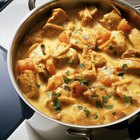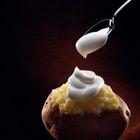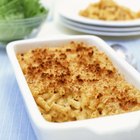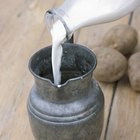
Discovered by accident thousands of years ago, yogurt has become a staple in home cooking. A quick and calcium-filled snack for a hungry kid or a healthy means of adding a creamy taste to baking and cooking, the fermented milk product has a variety of uses. However, when attempting to make a yogurt-based sauce or a simple curry, yogurt's creamy texture often breaks, leaving a curdled mess. A few simple techniques can prevent this devastation and result in a break-free and smooth sauce.
Acids
Adding acidic ingredients like lemon juice, vinegar and even fruits can curdle both milk and yogurt. Using whole-fat yogurts reduces the curdling effect, and cooking at a low temperature can offset the effects of acid. However, the best way to keep a yogurt-based food from curdling is by omitting acids or substituting them for milder, more pH-neutral ones. Serve acid-based compotes or chutneys on the side, for instance, instead of stirring them into yogurt during a recipe's cooking process.
Temperature
Heat is one of the main reasons for yogurt curdling. To maintain the smooth texture of yogurt while cooking, add the yogurt at the end of the dish's cooking time; avoid bringing the dish to a boil, and remove the dish from the heat, then stir in the yogurt.
Stabilizers
Using a stabilizer in a yogurt-based dish to keep it from curdling is one of the most common steps in Indian cooking. Whisk in a small amount of chickpea flour, cornstarch, or plain all-purpose flour to stabilize the yogurt before cooking. Ensure that the stabilizer is completely combined, then add the combination slowly to a low-temperature dish, or heat the stabilizer slowly on its own, again keeping it from boiling, and stirring it in at the end of the preparation.
Yogurt Types
The type of yogurt plays a large part in whether it will curdle. Buffalo-milk yogurt is less prone to curdling overall, and is commonly used by traditional Indian cooks. However, if this is unavailable, substitute full-fat yogurt, or Greek yogurt, where much of the water has been removed; both are less likely to break than low-fat yogurt, because the fat within the yogurt keeps proteins from clumping together and curdling. If you want to use low-fat products, only use a small amount of acid in the recipe, use a stabilizer in the yogurt and cook on low heat to prevent curdling.
Related Articles

Can You Bake Greek Yogurt?
How to Use Yogurt or Sour Cream Instead ...

Why Does Milk Curdle When it Is Mixed ...

Cooking Yogurt Without Curdling It

What Can Be Used as a Substitute for ...

What Makes Homemade Chai Curdle?

What Happens When You Heat Up Greek ...
How to Save Homemade Yogurt That Didn't ...

Does Cooking With Yogurt vs. Sour Cream ...

Low Fat Substitute for Mascarpone

Why Does a Sauce Curdle?

A Substitute for Sour Cream in Chicken ...

What Is Balkan Yogurt?

What Are the Functions of Pectin in ...

How to Keep Scalloped Potatoes From ...

What Can You Use in Place of Egg Yolk ...

Can You Use Milk Instead of Cream for ...

Greek Yogurt as a Replacement for Sour ...

What Can I Use to Thicken a Cream Sauce?

Substitute for Heavy Whipping Cream in ...
References
Writer Bio
Based in Kingston, Canada, Samantha Lowe has been writing for publication since 2006. She has written articles for the "Mars' Hill" newspaper and copy for various design projects. Her design and copy for the "Mars' Hill" won the Associated Collegiate Press Pacemaker award in 2008. Lowe holds an Honors BA from Trinity Western University, and a MSc in Occupational Therapy from Queen's University where she is currently doing her PhD.
Photo Credits
John Foxx/Stockbyte/Getty Images